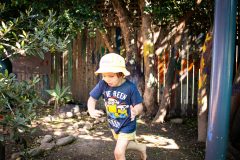Seven ways yoga can reset children’s social and emotional wellbeing

Conversations about children struggling to regulate their stress levels or to manage their anxiety are more prevalent than ever before. Stressed and anxious children are often children who show heightened behaviour, which in turn leads to stress and anxiety in those who care for them.
So what’s the answer? How do we support children to be less anxious, less stressed, and more ready to deal with the issues they face? Many early childhood educators have found that yoga can deliver just that.
- Yoga enhances social connections
Children usually attend yoga through environments such as classes at a yoga studio or through their kindergarten or school. Specialised children’s yoga instructors are trained in group and partner work that brings everyone together. Important social skills such as turn taking, respect and listening are embedded into these classes as part of the yoga philosophy, to unite.
- Yoga is fun!
Children’s yoga is nothing like adult yoga. Yoga for children is based on engaging them so children’s interest remains high. To keep children interested, yoga sessions have to be fun. It is often play based and includes activities that involve games, music, story telling, singing, imaginative thinking, the use of props and resources, creative movement and lots of laughing. Happiness comes from having fun, which in turn releases endorphins that reduce stress.
- Yoga connects children to themselves
Once children connect to themselves, they begin to connect to others more easily. Yoga brings their attention to their physical body and through the poses children learn how their body works. Through this body connection children develop their understanding of how they feel and what emotions arise during the yoga session. Yoga instructors are trained to guide children to understand their mind body connection better.
- Yoga increases focus and concentration
When children are holding a balance pose, for example, they need to find something to focus their gaze on so they don’t fall over. The more they learn to focus while doing a yoga pose, the more they are training their brain to concentrate. Focus and concentration are learnt skills.
What better way to teach children how to learn to do this, than through actual movement! Children move to get into a pose, then try to hold it for a couple of seconds. It’s very challenging for some children to learn to be still without inviting some movement, such as sitting crossed legged on the floor while listening to a story. Children naturally want to move!
- Yoga is non competitive
Children learn to master skills in a non-competitive way, through repetition and practice. There is no beginning or end or winners or losers in yoga, unlike most typical sports. Therefore, children who struggle in competitive environments can accomplish skills at their own pace, without fear of failure or being the last to achieve something. Learning at your own pace enhances self esteem.
- Yoga teaches children respect
Respect is an important value to understand. Children learn respect through respecting themselves by listening to their mind and body, by showing respect towards others, such as in group settings and finally, how to respect the environment they are in by looking after everything within their space. When we role modelling what respect looks like to children through our own actions, as well as labelling what respect is, such as, “please show Mary respect by not touching her”, we are helping children to define respect in ways they can relate to.
- Yoga helps children to slow down
When children are holding a pose, they have to stop, even if it is just for a few seconds. Gradually over time, as children adapt to becoming still, their time spent being still will increase. Breathing techniques is another aspect of yoga that assist in this slow down process. Through breath control children can alter their physiological states, this means they can slow down their heart rate, which in effect induces a state of calmness. Children can learn to use their breath as a coping tool in everyday situations when emotions are heightened.
Yoga is said to be practised as much off the mat, as it is on the mat. This basically means that the underlying principle of yoga is to connect to yourself and others. When you are able to recognise what is going on in your own body, you will eventually open yourself up to a deeper understanding of what is going on in your mind.
What this means for children is that they learn to respond to their feelings and emotions, as opposed to reacting to them. All of the points listed can bring about a mind body awareness to children to enhance their social and emotional wellbeing, with a little bit of fun thrown in to keep it age appropriate and engaging.
Nic would love to hear from readers with their questions about integrating yoga into their work with children.
Strong communities are the foundations of Nic’s two yoga programs – Yoga Play for kindergartens and Earth Mother Yoga for mums and children. Join Nic’s community by liking South East Yoga & Wellbeing Facebook page and sign up for the monthly newsletter for a free PDFon Calming Bedtime Routines at info@southeastyogaandwellbing.com


















